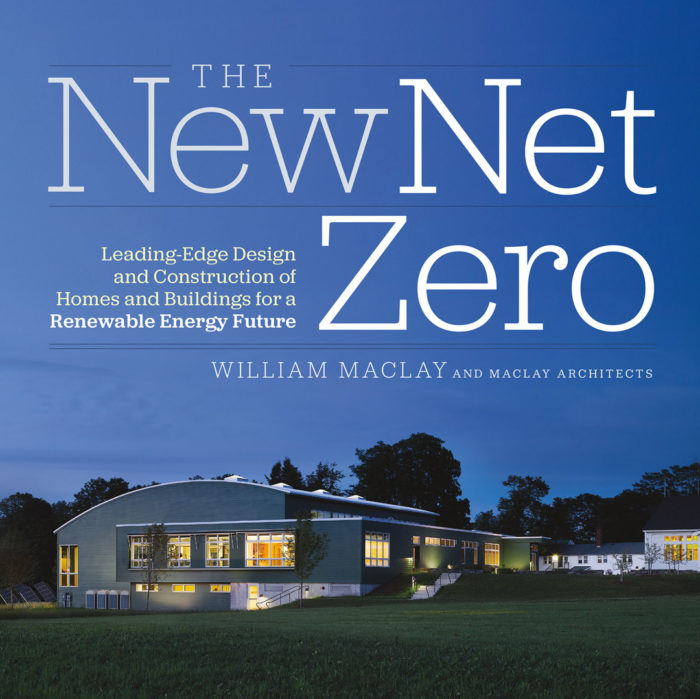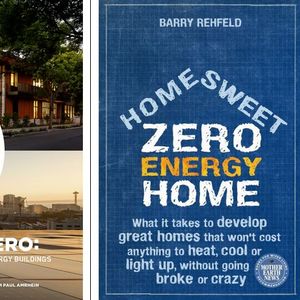
Image Credit: Chelsea Green Publishing
If you are a cold-climate architect looking for a reference book that provides guidance on designing energy-efficient superinsulated buildings, I strongly suggest that you buy William Maclay’s The New Net Zero. It’s the best book on the topic by far.
Bill Maclay is an architect based in Warren, Vermont. I first met Bill 21 years ago, in the spring of 1993, when I was working as a project manager at Northern Community Housing Corporation, a nonprofit developer of low-income housing. Bill was chosen as the architect for a mixed-use commercial and residential building that our office was building in Hardwick, Vermont.
With help from energy consultant Andy Shapiro, Maclay designed a building that was ahead of its time. It had double-stud walls filled with dense-packed cellulose, and was built with close attention to airtightness. Ventilation was provided by several heat-recovery ventilators. The building uses far less energy per square foot than most other Vermont buildings built in the early 1990s.
Over the years, I’ve followed Maclay’s career, and have written several articles on buildings he’s designed, including “Solar in the City” (Energy Design Update, September 2002), a profile of Pat Hanson’s superinsulated house in Burlington, Vermont.
The New Net Zero is a remarkable achievement. It is a generously sized 553-page hardback that is lavishly illustrated with full-color photos and architectural details.
Maclay explains the principles behind good design
Maclay’s book is comprehensive; it could easily serve as a textbook. Maclay introduces all of the topics that form the basis of an intelligent discussion of energy-efficient design, including building science fundamentals, principles of building enclosure design, the different definitions of “net zero,” renovation vs. new construction, and cost-effectiveness. He also presents case studies.
Many of the buildings that Maclay chooses as case studies will be familiar to…
Weekly Newsletter
Get building science and energy efficiency advice, plus special offers, in your inbox.

This article is only available to GBA Prime Members
Sign up for a free trial and get instant access to this article as well as GBA’s complete library of premium articles and construction details.
Start Free TrialAlready a member? Log in















16 Comments
Good Reviews
Thank you for your reviews of these books. I have been purchasing all of the Passive House books published over the last few years, and most have been rather lacking on useful information. From your review, I will be purchasing the "New Net Zero" book. It sounds detailed enough to actually be useful.
On another note, how is the Pretty Good House book project progressing?
Response to Steve Young
Steve,
I haven't been involved with the "Pretty Good House" book proposal -- I think that Chris Briley was the main promoter of the idea. I just sent Chris an e-mail to ask him if there is any news on the project.
OOPs
Sorry, for the confusion on my part.
I am looking forward to hearing any news on a PGH book.
PGH book
We occasionally meet and plot but never have time to get it moving. Keep hope alive! We've lost one of our inner quartet to the PH borg but we're hoping to rescue him.
Response to Dan Kolbert
Dan,
A former PGH believer has drunk the Passivhaus Kool-aid?
As Dan Said...
Everyone involved has their primary day jobs of designing and building great buildings, so it's been difficult keeping the momentum. This winter things will pick up again.
Great useful blog
Martin now this is a useful blog... I rate it a 10 verses a 0 for the Tyvek taping lesson
Book Reviews
Martin wrote: What does the author mean by “sustainable”? He gives us several hints, as when he writes, “This book is about making better buildings. Better buildings don’t wreck the planet. Better buildings do not waste resources.” Magwood strongly prefers natural materials to store-bought materials: “Today, a smart, well-intentioned builder could make an amazingly efficient and comfortable modern building out of local materials as basic as earth, clay, timber, straw and stone.”
Although straw-bale builders and adobe fans might be interested in this book, most green builders will probably end up rolling their eyes or throwing the book against the wall in frustration.
I think you missed the main point that is non-debatable. Quality Control is in the hands of the manufacturer when you purchase a product from the store. You are at the mercy of their material data sheets, testing, MSDS, and perhaps LIES! OSHA controls the MSDS for work hazards, not installation or sustainability. The EPA has no control, nor does ASTM, or anyone else, there are no regulations to prove the installation is safe, or will sustain. To show sustainability, a cyclic test by a third party needs to be controlled and conducted, better than nothing, but not complete Quality Control. I think as time goes on, and we seal in more toxins, or materials fail, this will be replaced by builders wanting Quality Control and Assurance. The only way to obtain that is become the manufacturer. Perhaps then, these so called “green builders” will regret throwing the book against the wall and wish they had thrown the manufacture out the door. There is a lot, as much if not more, to know about building with natural materials that sustain the test of time. I think it is a myth to say they last longer since they have been around longer. However, if properly done there is plenty of evidence they sustain more the average factory product. Remember, the factory goes out of business if they design to fail for too long. Besides, what better way to cut down on embodied energy and support your local economy.
Martin wrote: So, did this basement solution really deserve five pages, now that we know that it’s not code-accepted? (Probably, at least for Magwood. Most of the construction methods he discusses aren’t code-approved.)
We recently had a code board meeting to adopt earth and bale construction. When I explained the benefits to the local farmers, quarries, and economy, the board became VERY supportive. They are not familiar with these methods of the past. I will be taking the analytical path described in “Administration” section of the IRC, R104.11, which allows “Alternate materials, designs, and methods of construction and equipment”. Some methods will require lab testing, a PE for the structures part. So I do not see code stopping anyone, it may decrease their R&D cost, but not by much, $1000-$1500.
I think Magwood was referring to the manufacture of Portland cement and its carbon footprint. Fly ash, pozzolans, magnesium’s, are being substituted. As a matter of fact, I am picking up some fly ash this week. Problem is there are stiff transportation regulations, you may be able to find it bagged. You can get it by contacting a local power plant or one of their distributors. It is the waste off the kilns, burner stack walls, it has cement like properties…there are other forms of pozzolans that only need low temperature to manufacture or are derived as a mineral from the earth, calcium and magnesium. Mag is very expensive. You put together a mix, go get it tested at a lab. Take the alternate material code path.
Martin wrote: In fact, the worrisome substances affecting indoor air quality aren't the vapors behind your drywall; the real culprits include tobacco smoke, radon, formaldehyde from kitchen cabinets, and particulates and gases released by cooking.
I think carbon monoxide is one the biggest since it stops the blood from getting oxygen. My wife is an Oncology nurse, all the doctors and seminars she has learned from finds controversy is establishing a direct link to cancer. I think a court of law would struggle. Again, a builders best solution is take the manufacture of toxic materials in their own hands, realize when things go wrong, which it less likely, there will be no one to blame but the builder.
Martin wrote: Sometimes the quotes that Kellner chooses from her owner/builder interviews don’t make any sense, as when Aaron Powers describes the advantages of straw-bale walls. Aaron explains, “Should you have to use some glues, which we tried to minimize, this house doesn’t allow it to get trapped inside. It’s breathable. You’re getting more air exchange through the walls.” If Aaron managed to build a straw-bale wall that leaks air, that’s nothing to brag about.
Agree, “through’ the walls is a mistake, can cause R-value drops, moisture, rot, just like batts etc…this contradicts code not only logic. Other methods of mass such as cobb or rammed earth do not need sealing with glues, are more resistant to moisture and air infiltration such as earth or clay, but, ACH still needs to be low with the right ventilation.
Think I’ll stick to GBA for my learning needs and “The Man” Martin :)
Here are two books I found good, it comes with a DVD that takes you to their jobsites. It’s out of Vermont and mainly focuses on strawbales, but I was able to apply the cold climate principles to my hot/humid-cold climate zone. Easy reading, but you can tell these guys are either Engineers or had some help writing the book. Like any book, you have to put the knowledge to practice which I am now.
https://www.youtube.com/watch?v=tvX-54gbXis
Earth updated to 2012: You learn it is not as easy as throwing dirt in forms, there is a myth that these methods are ‘labor intensive’, there are MANY ways to cut labor down. I have projected my cost from a reduction in material cost and trades I have to manage, to at or below stick mainstream construction cost. My air sealing efforts will be small. As we build more and the learning curve gets in line with our mainstream we do plenty of, we will be well below it. As we get more comfortable, we will move the methods to our rennovations and restorations as applicable.
http://www.ebay.com/itm/like/301230496575?lpid=82
Thank you!
Forgot to say thank you Martin for the non-bias pros and cons reviews. I’d like to take this opportunity to also thank you for the site. It is only high traffic site of the net that has mainstream and ‘alternative’ natural building collaborations and discussions. Other sites mock or prefer the two or will be bias. For me, this site brings them both together and allows open dialoge of either. Keep up the good work!
Response to Terry Lee
Terry,
You wrote, "Quality Control is in the hands of the manufacturer when you purchase a product from the store. You are at the mercy of their material data sheets, testing, MSDS, and perhaps LIES! .... Perhaps then, these so called “green builders” will regret throwing the book against the wall and wish they had thrown the manufacturer out the door. "
I think your attitude is unnecessarily cynical. It's pretty hard to build a house without using manufactured products. Learning about products and building materials requires builders to study; but abandoning manufactured materials is impossible for any house with interior plumbing and electricity, and is very rare even for a cabin without plumbing or electricity.
Lets not take what I wrote out of context Martin....
Perhaps, I should put the disclaimer take QC in any possible way you can.....that is QA.
What I wrote in full.....in response to Martins view of "most green builders", just a tad bit cynical :)
Maritn: Magwood strongly prefers natural materials to store-bought materials: “Today, a smart, well-intentioned builder could make an amazingly efficient and comfortable modern building out of local materials as basic as earth, clay, timber, straw and stone.”
Although straw-bale builders and adobe fans might be interested in this book, most green builders will probably end up rolling their eyes or throwing the book against the wall in frustration.
Terry: Quality Control is in the hands of the manufacturer when you purchase a product from the store. You are at the mercy of their material data sheets, testing, MSDS, and perhaps LIES! OSHA controls the MSDS for work hazards, not installation or sustainability. The EPA has no control, nor does ASTM, or anyone else, there are no regulations to prove the installation is safe, or will sustain. To show sustainability, a cyclic test by a third party needs to be controlled and conducted, better than nothing, but not complete Quality Control. I think as time goes on, and we seal in more toxins, or materials fail, this will be replaced by builders wanting Quality Control and Assurance. The only way to obtain that is become the manufacturer. Perhaps then, these so called “green builders” will regret throwing the book against the wall and wish they had thrown the manufacture out the door. There is a lot, as much if not more, to know about building with natural materials that sustain the test of time. I think it is a myth to say they last longer since they have been around longer. However, if properly done there is plenty of evidence they sustain more than the average factory product. Remember, the factory goes out of business if they design to sustain for too long. Besides, what better way to cut down on embodied energy and support your local economy.
We can agree on both being just a tad bit cynical, lol! Perhaps being in a factory for 30 years and seeing how they design left a bad taste in my mouth.
The New Net Zero
Martin, I took your advice and sprung for William Maclay's book. It is a fantastic resource. I'd recommend it to anyone. Thanks for the review.
Response to Malcolm Taylor
Malcolm,
You're welcome. I'm glad that my review was helpful, and I'm glad that you agree with my assessment of Maclay's valuable book.
A Bit More Detailed Comment
A very thorough examination of the whole wide range of topics around energy efficient building.
If there is one weakness (which seems to be common to all these discussions) it is that although the book has some detailed analysis on the economics of everything from PV to future energy costs, it gets a bit vague around the mark up for going from conventional construction to net zero. Sometimes he cites a 5% figure, sometimes it grows to 15. His suggestion of simply reducing the floor area by the same percentage isn't all that helpful, as floor area doesn't directly correlate, some of the larger costs being incurred regardless of size.
I know it isn't a straightforward thing to do, but I wish there were more detailed comparisons between the costs of various approaches - including the expenses associated with accreditation for things like Leed and Passive House. Advocates for them are are not good sources. I wish more objective information was available to help the debate.
Response to Malcolm Taylor
Malcolm,
While it can be quite tricky to generalize about the cost of insulation upgrades, it's fairly easy to estimate the cost of a PV system.
It's fairly safe to say that a PV system costs $4/watt. (This price is dropping, of course; in some areas of the country, the price is now $3.50 or even $3.00 per watt.)
To find out how many kWh/year your PV system will produce, use the online calculator at PVWatts.
Great reviews
These reviews are a great help. Thanks for taking the time to help us find the appropriate information.
The pretty good house book idea however could trump them all. As Martin has stated in the past the vast majority of homes built or remodled are not shooting for ph or net zero but could be nudged toward pretty good thus making an overall greater impact. (Martin, please don't let me put words in your mouth, if I'm mistaken let us know to avoid confusion) so if a Pgh book is more appropriate for the masses, this could translate to a win win for the writers, publishers, manufactures of good energy conserving products, and maybe change average home energy useage as a whole. Pretty exciting stuff.
Can't wait to see that book on the shelf.
Rusty
Log in or become a member to post a comment.
Sign up Log in